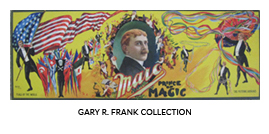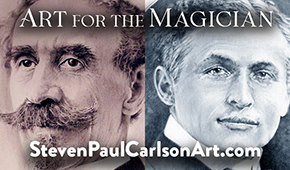Little Journey to the Grave of Maro the Great
Category: Article Posted by: SAMUEL PATRICK SMITH
A Little Journey to the Grave of Maro The Great
By Terry Evanswood
.jpg) It all started with a phone call from the Dunham Hunt Museum in my hometown of St. Charles, Illinois. Every October, in association with the St. Charles Historical Society, the museum would host our annual “Cemetery Walk.”
It all started with a phone call from the Dunham Hunt Museum in my hometown of St. Charles, Illinois. Every October, in association with the St. Charles Historical Society, the museum would host our annual “Cemetery Walk.”
On the appointed day, groups arrived at the graveyard every hour on the hour to follow a guide map and visit the markers of prominent St. Charles citizens. Both professional and amateur actors were brought in to reenact stories from the lives of those laid to rest in the old North Cemetery. I questioned why they were requesting my assistance. I was informed that Walter Truman Best, a famous magician from an earlier era, was buried in our hometown graveyard. His stage name was Maro. I was the current resident town magician, so I was invited to play the part of “Maro the Great.”
I eagerly accepted and began my research for my role of this magician who was unknown to me at the time. Our historical center had archival newspaper clippings regarding the Great Maro. There wasn’t much documentation, but I did turn up some basic biographical facts. I learned Maro had married Allie Kaiser, the daughter of a St. Charles businessman. I also found his show content information that would allow me to develop my character and a list of magical effects that I could duplicate while paying tribute to him. Maro died from typhoid fever in 1908 at the age of thirty-nine.
Among my more interesting discoveries was a newspaper photo of a team of horses hauling a three-and-a-half ton boulder to North Cemetery. He had requested that this massive rock be moved by railroad from his childhood home in Leland, Michigan to St. Charles, Illinois to be used to mark his final resting place. This request was finally fulfilled in 1910, two years after his burial.
The Great Western Railroad line transported the monument to the station that once stood along the Fox River in downtown St. Charles. This boulder, spanning two flatbed carriages, was then pulled by four horses up the Main Street hill to North Cemetery. Quite an amazing feat given the size and weight of this stone. The news article reported that the monument was over six feet high. This would make it easy for me to find on the day of the reenactment, I thought.
I donned my period clothing and arrived at North Cemetery that morning in October of 1993. I was eager to see the unusual granite monument towering high above the ground-level markers. It was nowhere to be found. I did however, locate a large boulder lying flat in the middle of his wife’s family plot, the Kaiser plot. The boulder did not have Maro’s name on it but I assumed it was the correct location. In nervous preparation of entertaining the tours, I didn’t give it another thought.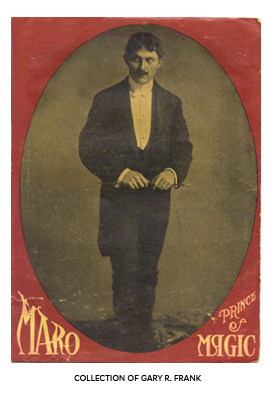
It wasn’t until the first group passed through, as I sat on that rock, that it dawned on me. This was Maro’s grave marker. The monument must have, through time or vandalism, found its current horizontal position. Was it possible that Maro’s name plate was not showing on the stone because it was face down, pressed between the earth under three-and-a-half tons of granite? Daydreaming between groups whether I’d ever know, I worked this theory into the script of the next tour.
Standing atop the stone stage as Maro, I would tell the tour groups my intentions. “One day a new St. Charles-based magician will raise my stone and secure my memory.” My words guaranteed a round of applause from the assembled crowd. When the next tour passed, I had convinced the audience that Maro’s name plate was on the underside of the stone. By the time the last tour ended, I had convinced myself it was there.
As dusk set on North Cemetery that day, I couldn’t stand the thought of the effort endured and the money spent to bring that stone across the county only to have it fall flat over time. It’s not fair that the name of this renowned, accomplished magician was in all likelihood face down in the mud, never to be recognized or see the light of day. I promised myself and Maro that if I ever had the ability and the wherewithal to correct his monument, I would make it happen.
Because of a full-time performance schedule in Pigeon Forge, Tennessee, opportunities one year at a time slipped away with the hope of “maybe next year.” It took seventeen years on my mental rotation before the resurrecting would be possible.
The year 2010 marked the one hundredth anniversary of the placement of Maro’s stone. This monument had rested on its face for far too long. Its restoration could no longer wait. I convinced our theater management I needed a few days off to fulfill a longtime promise.
I arrived home and began cutting through the red tape. I had to acquire permission from the grounds, any living relatives of the Kaiser family, and the city of St. Charles. Through my father’s long-time association in town, I secured the assistance of the Drieson Construction Company, which had the trucks and lift capacity needed for the job. My brother, Mike, an active stone and brick mason in our town, oversaw the project and engineered a plan. I acquired the permission, bonds, and insurance to cover the risks involved in maneuvering this heavy machinery through dozens of century-old tombstones. My formidable goal was going to be achieved!
On September 17, 2010, the physical process began. As attempts were made to lift the stone, members of the Dunham Hunt Museum, the St. Charles Historical Society, my family and friends watched with eager anticipation, but no one was more excited than me. Heavy lift straps were secured around what would be the top of the stone and it slowly began to rise from the ground one inch at a time.
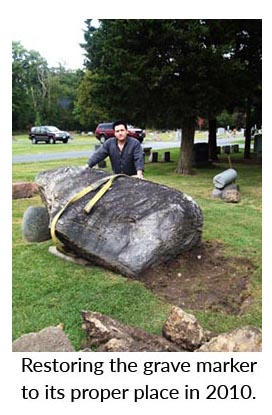 Under the great weight of the rock one of the straps snapped in two, giving testament to the size and the mass of the solid granite. The stone fell hard back into its indentation in the earth. Several onlookers remarked at how a few men and a few horses accomplished this job in 1910. We all met to attempt to reevaluate the situation and find an alternative method. Any other modern machinery that would guarantee success would never be able to be negotiated though the narrow paths between the other monuments.
Under the great weight of the rock one of the straps snapped in two, giving testament to the size and the mass of the solid granite. The stone fell hard back into its indentation in the earth. Several onlookers remarked at how a few men and a few horses accomplished this job in 1910. We all met to attempt to reevaluate the situation and find an alternative method. Any other modern machinery that would guarantee success would never be able to be negotiated though the narrow paths between the other monuments.
We decided to try again. Double straps were secured and we watched it inch off the ground. Large wooden beams were then wedged under to help take the strain off the lift. I knelt down as close as I safely could in anticipation of what I might see. When the top was angled about twenty inches off the ground, there was enough light to see a nameplate covered in mud – it was there!
I wiped away the mud, like feeling braille, and discovered raised letters. As the stone reached its original upright position the sunlight finally illuminated the words:
E. MARO
Walter Truman Best
1868 – 1908
A new concrete base was poured, surrounding the bottom eight inches of the stone to ensure it would remain upright. While the concrete was still setting, stone rabbits were placed in the corners of the platform to remind those passing by that a great magician rests there.
One by one, workers and guests left until I stood alone and watched the sunset on Maro’s name for the first time in more than one hundred years. I left for the long drive back to Tennessee, feeling satisfied that the efforts of long ago were restored. There was no fanfare or celebration, but I felt somewhere Maro the Magician was smiling – and that was enough.
It was enough for me, but apparently not enough for Maro. He still had a few tricks up his sleeve.
On the trip home, I contemplated acquiring one of Maro’s famous posters. 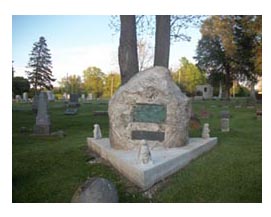 Specifically, his “Flags of the World” banner lithograph. If I could find one, I would feature it in my antique magic collection on public display in the lobby of my theater in Pigeon Forge, Tennessee – The Hall of Magic Museum.
Specifically, his “Flags of the World” banner lithograph. If I could find one, I would feature it in my antique magic collection on public display in the lobby of my theater in Pigeon Forge, Tennessee – The Hall of Magic Museum.
In 2012, after I had just completed writing what I thought was the complete Maro story for publication in The Linking Ring, a surprise encore was about to reveal itself. My theater management handed me a copy of an e-mail they received on my behalf. I could not believe my eyes. Included with the e-mail were pictures of five original Maro lithographs, including the “Flags of the World” banner. The correspondence accompanying these images told an unbelievable story. The writer explained that, in the 1930s, his grandparents purchased Maro’s home in Leland, Michigan, from Allie, Maro’s widow. She left many personal effects behind, including Maro’s own collection of his publicity posters that were used to advertise his tours that crossed the country.
I assumed the owner of this poster collection had found me on the Internet because of my efforts to restore Maro’s gravesite. I assumed wrong. He explained he had visited an antique shop in his current hometown of Morgantown, Georgia, in an attempt to sell the posters. Lucky for me, the proprietor of the shop had no interest in magic posters. Unbelievably lucky for me, she had just taken an out-of-town trip to, of all places, Pigeon Forge, Tennessee, and had seen my show and the Hall of Magic collection. She suggested that he contact the magician in Pigeon Forge, Tennessee. He did! After hearing about my long-time Maro connection, he insisted the posters should be in my display.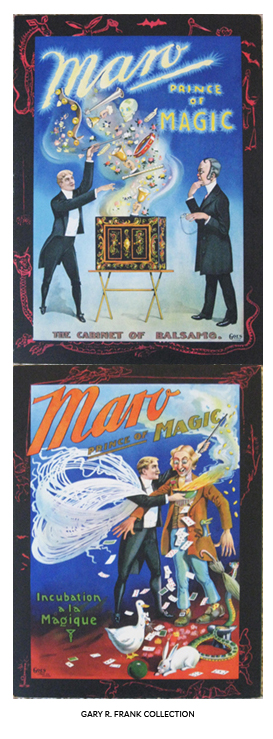
Not only did all five posters arrive, there were more surprises to discover. Among the posters was a substantial amount of previously unseen printed documentation on the life of Maro, The Prince of Magic. Another treasure included with this collection was a heavily engraved ornamental Indian dagger which was found under a stairway in Maro’s home. The inclusion of the dagger was a mystery to me until my research revealed that Maro had assembled a world-renown collection of ornamental daggers. These served as his personal souvenirs from his travels.
Through this unbelievable series of circumstances, Maro’s personal collection found its way to me. My chapter of the Maro story was finally complete. It made me smile – and to Maro, that was enough!
